~ The Crwth ~
As far as I have one, the crwth is my main instrument as it has been now for more than 20 years. The word is, of course, Welsh - the W being pronounced as the vowel (crooth / or cruth) and relates in some way to the Old English names crowd and cruit; both of which are associated with this type of instrument: namely the bowed lyre which is for all intents and purposes identical to instruments such as the one illustrated below from an Egyptian tomb painting circa 1900 BC.
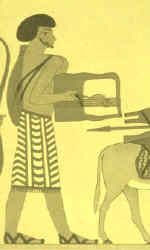
The playing technique here is quite clearly visible: the player strums the strings with a long plectra held in his right hand whilst he stops the strings he doesn't want to sound with the fingers of his left, a technique that can be heard to this day in extant lyre playing traditions of North Africa & elsewhere. It would appear that the bow itself evolved from such plectra after the lyre had made its arrival in Northern Europe at some point during the early Christian era, for not only do the earliest iconographical evidences of the bow depict its application to lyre strings, but it is as a bowed instrument that the lyre survived in Northern Europe from medieval times until well into the 20th century.
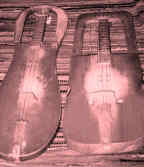
The two crwths I use were both constructed by Tim Hobrough during the 1980's. The first, the Round Crwth, is based on an instrument depicted in an 11th century manuscript from Limoges in Brittany in the hands of King David thus:-

and again some 900 years later on iconography produced by the London & North Eastern Railways from which it might be surmised that the crwth was first brought to Durham by medieval pilgrims arriving by rail as late as 1931.
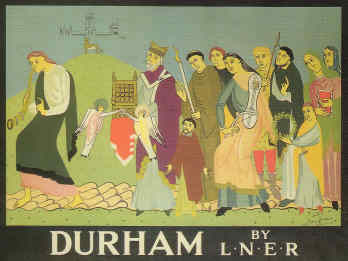
Whilst the details in the Limoges image are fairly vague, what is clear is the beautifully balance & symmetrical curvaciousness which served as basic pattern for my own instrument which has been with me now since 1983 and has been used in musical contexts as diverse as the inauguration of Metgumberbone through to concerts of medieval music and all points in between.
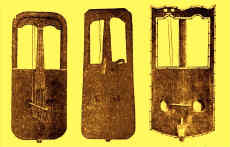
The second crwth, the Square Crwth, was built with reference to certain extant originals from the 18th century, such as those illustrated above, albeit modified slightly to suit my own playing requirements which varies from age to age as an examination of the bridge below will testify.

The different depths and positions of the string grooves are the result of an ongoing struggle to achieve the optimum results from this instrument. Also clear from this image is one of the more celebrated features of the Welsh crwth bridge, which has the treble foot resting on the top of the instrument whilst the bass foot passes through the sound-hole to rest on the back. Less celebrated however is the notion that crwth bridges really ought to be completely flat making it only possible to bow all of the strings simultaneously: I've come across published dogma stating that anyone who has a crwth with a curved bridge is not in possession of a crwth at all but rather a violin shaped like a crwth. Such, alas, is the mentality of the fundamentalist enthusiast for whom Authenticity is the umbilical escape route into the historical never-never glorified in the name of Heritage (though readers might take heart that John Cale is said to have flattened his viola bridge so as produce a sound analogous to how he imagined the crwth might sound...)
For the record, the bridges of both my instruments are slightly curved making it possible to bow the strings individually or in multiples enabling a subtlety of harmonic technique that has been 20 years in the making and would be absolutely impossible with a flat bridge. It may also be noted on both instruments that whilst most of the strings pass over the fingerboard there is one that deviates over the adjacent opening - this is an octave drone which can be bowed or plucked, depending on the usage. It is the sonorous booming of this string that is one of the distinctive features of not only the crwth, but also the music in which it finds itself.
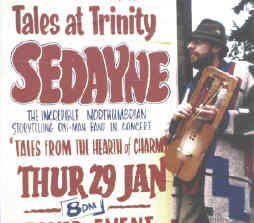
Click image for appropriate audio
The fact that both instruments are fretted (with Drennan Specimen Plus 16lb fishing line) has raised a few eyebrows over the years too. Personally I like frets, their presence is a joy to me & without them I'd be quite stuffed to tell you the truth (and whilst I would not claim to be even worthy of mention in same breath as Jordi Savall, hence the parenthesis, I note with interest that all of his medieval bowed instruments are also fretted). So let pragmatism triumph over pedantry, as it has in my dealings with the crwth over the past twenty years - just a word, just a piece of wood with strings on...
Spontaneous autumnal improvisation on the DOROMB (Hungarian Jew's Harp by Zoltan Szilagyi) and CRWTH (mediaeval bowed Celtic lyre by Tim Hobrough) performed by Sedayne in Houghall Woods, Durham, UK, September 2006.
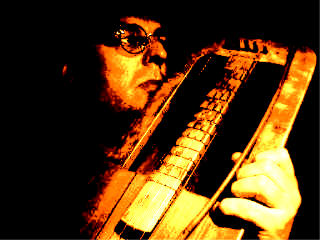
contact, for whatever reason:- crwth@sedayne.co.uk